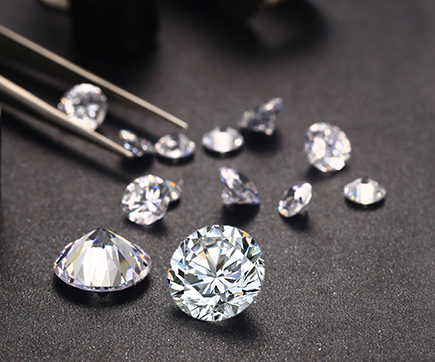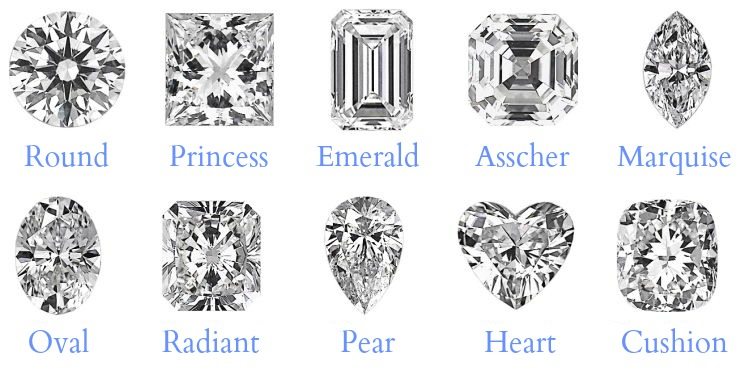Adamas and adamant were words implying extreme hardness, derived from the Greek adamao meaning 'I tame' or 'I subdue'. They were used in classical times to describe sapphire (corundum), which was sometimes confused with diamond. In the Bible, God tells the prophet Ezekiel (Chap. 3, verse 9), 'As an adamant harder than flint have I made thy forehead.' Adimantum, a common Greek variation of adamant, is probably the root word of the old French diamant and the English dyamaund and adamaund, used at the beginning of the fifteenth century, as well as the poetic dimaund. The modern spelling originated in the mid-sixteenth century. 
For many centuries, adamant referred to lodestone as well as hard materials such as diamond and corundum, owing to confusion with the Latin word adamare, 'to attract'. William Shakespeare used it in this sense at the beginning of the sixteenth century in Troilus and Cressida with the words, 'as a turtle to her mate, 'As iron to adamant', but about sixty years later, John Milton was employing it in its original sense in Paradise Lost: 'Three folds were brass, Three iron, three of adamantine rock.' Adamantine, as used today, refers to the quality of impenetrable hardness, as in 'the adamantine lustre of a diamond's polished surface'.
The wearing of jewellery is as ancient a custom as any on record and appeared in early societies to be of primary importance after the seeking of food and shelter. It has been conjectured that the wearing of pretty stones was originally motivated by a desire to remember the spring with its promise of food and warmth, and later became the personal adornment or the symbol of rank or wealth that it is today.
Large diamonds were badges of rank worn by rulers and also convenient portable wealth in the early days of India. Most of the historical diamonds that still exist are Indian, and all have had eventful and sometimes bloody histories. Tavernier brought a number of them to Europe. The Koh-i-Nur, or Mountain of Light, has the longest history of all famous diamonds as it was known to be in the possession of the Rajahs of Malwa as long ago as 1304 and was facetted no later than 1530. It is believed to have been set by the Mogul emperors in the famous Peacock Throne as one of the peacock's eyes. The other eye was the Akbar Shah diamond. The Persian Shah took the diamond when he invaded India and later it came into the hands of the 'Lion of the Punjab' who accepted it in return for military help that he never gave. Eventually, it was taken by the East India Company against losses and presented to Queen Victoria. 
The 410 carat Regent Diamond played a part in the French Revolution. It was one of the last big diamonds to be found in India, in 1701. It came to England and was named 'the Pitt', and the major part after recutting was resold to the Regent of France when it acquired its current name. Later Marie Antoinette wore it and on 17th September 1792, it was among the French Crown jewels that were stolen during the early stages of the French Revolution. Most of the treasures were quickly recovered but the Regent diamond did not come to light until fifteen months later when it was found in a hole in a beam of a Paris garret.
During the Directoire period, the Regent and other diamonds were pawned to a Berlin banker for 4,000,000 francs to keep fourteen French armies in the field. It was redeemed and then used as a guarantee for a loan from a Dutchman. After it was again recovered, Napoleon Bonaparte had it set in the hilt of a sword he carried when being proclaimed Emperor of France. The Hope diamond, to which stories of tragedy have become attached, is supposed to have been part of the famous Blue Tavernier diamond brought to Europe by Tavernier. It was also stolen during the French Revolution but never recovered. The 442-carat Hope diamond is perhaps the largest of three parts into which the Blue Tavernier was cut. Hope's son lost his fortune after inheriting the stone. It was sold and eventually came into the hands of Mrs Edward B. McLean, who lost her child in an accident, saw her family break up, lost her fortune, then committed suicide.
Diamonds' effect on social history has been mainly because they are possibly the greatest concentrated form of wealth which is negotiable almost anywhere. They have played a part in many upheavals and during the recent world, wars paid the way for the escape of refugees from totalitarian tyrannies. From at least the fourth century B.C ., India traded in diamonds, taxed them and exported them. There had long been trading between India and Babylon, Mesopotamia, Syria, Israel, Egypt, Ceylon, and Arabian countries. Diamonds that reached the western part of the Roman Empire were prized for their magical powers, but Rome also re-exported them to China as tool bits set in iron holders for cutting jade and drilling pearls during the first five centuries A.D. There were no superstitions in China to deny this use and, even as tools, they were still regarded as presents fit for kings, according to the Chinese philosopher Lao-tse in the first century A.D.
